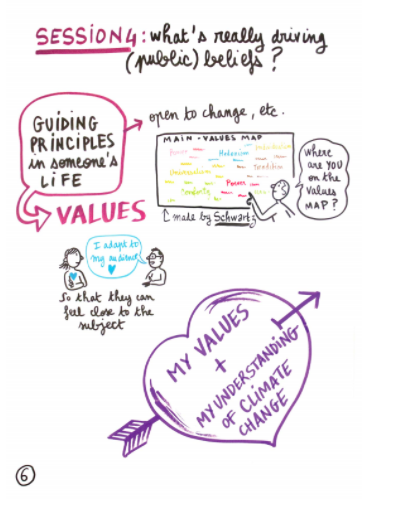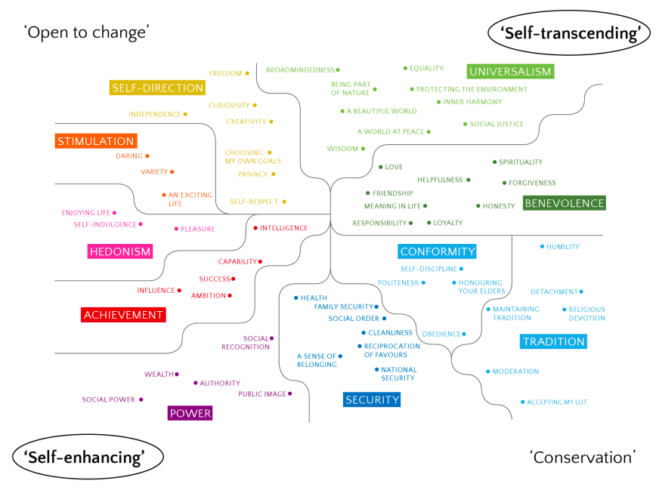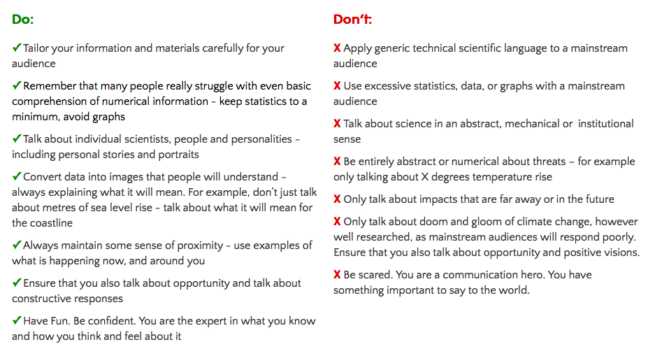A Guide to the Science of Climate Change Communication

Introduction
This resourcetakes a workshop approach with information and practical exercises that will give you knowledge of the science of climate change communication, and the confidence to apply this knowledge in practice with non-academic audiences. It is designed for all researchers across the physical, natural and social sciences.
The webpages within the resource draw on a series of training workshops held with with early career researchers in Europe between 2014-2017. The workshops were created and developed by Asher Minns, Executive Director at the Tyndall Centre for Climate Change Research in partnership with Adam Corner and Chris Shaw of Climate Outreach, as part of the Helix project.
This resource has the following aims:
- To provide an introduction to the social and political context of communicating climate change, as well as specific tips and guidance for researchers (introducing the science of communicating climate change).
- To increase the confidence and capacity of climate change researchers to effectively engage the public (building climate change communication confidence).
Provided below is a short summary of the resource. Access the full resource here.
In the resource
This resources contains the following pages:
Knowing your audience
You can get to know your audience better by taking time to reflect on these questions:
- Does your audience share your perspective and level of knowledge? Your wider views?
- Are there different ways you can ‘frame’ your message for different audiences, based on their knowledge of the subject and interests?
Getting to know what makes your audience tick will be important for building trust between you and your audience.
Understanding how you are heard and finding your authentic voice
There are unresolved questions about what climate change communication is trying to achieve and who should be doing it, and as a result there is a huge amount of room for dispute, disagreement and contestation.
Is the purpose of climate change communication to:
- provide clearer presentation of the science of climate change?
- build public engagement (attitudes, behaviours) with climate change as a societal risk?
- give policy makers the information they need in order to make good decisions?
Communicating uncertainty
With an issue like climate change, there will always be uncertainties. These uncertainties can be interpreted as meaning that the idea of anthropogenic climate change remains unproven.
There are ways your communication can minimise this misunderstanding:
- Manage expectations
- Shift from uncertainty to risk
- Focus on what we do know
- Emphasise the scientific consensus
- Communicate through images and stories
Bringing climate change into the here and now
Climate change is fundamentally a difficult problem to keep front of mind:
- It is not here and not now for most of us in Western nations
- With a ‘finite pool of worry’ other things take precedence
- We tend to think that climate change is more likely to impact people and places far away
- Taking action seems unattractive since the rewards for doing so are perceived as far off
- The inherent uncertainty in climate projections allows for wishful thinking.
In general, ‘localising’ climate change (for example, by communicating the current and future impacts of sea-level rise on local communities) has been shown to help reduce the sense that climate change is a ‘distant’ issue.
What’s really driving public beliefs about climate change
How can you start from the values the audience holds rather than the facts you want to get across?
People have a range of values, and may draw on different ones at different times, but certain types of values cluster together (while others conflict with each other). In particular, ‘self-enhancing’ values like wealth, status and power (lower left quadrant of Image 1 below) conflict with ‘self-transcending’ values like altruism and concern for the welfare of others (top right quadrant of Image 1 below).

Science and stories
Stories offer a way of building more sustainable and meaningful engagement with science because people are more used to communicating information through stories than graphs and numbers. The concept of using the narrative form for communication has become increasingly common among science communicators.
Do’s and dont’s of science communication

The resource also provides additional reading and references.
Suggested citation
Climate Outreach and the Tyndall Centre for Climate Change Research, 2017. A guide to the science of climate change communication. Available online: https://climateoutreach.org/resources/guide-science-of-climate-change-communication/?utm_content=buffer42886&utm_medium=social&utm_source=twitter.com&utm_campaign=buffer
Further reading
- The Uncertainty Handbook: A Practical Guide for Climate Change Communicators
- Building bridges and changing minds: Insights from climate communication research and practice
- Risk communication in the context of climate change
- Learning from failures in communication: sharing lessons from research & practice workshop
- Communicating climate change for adaptation: Challenges, successes and future priorities
(0) Comments
There is no content